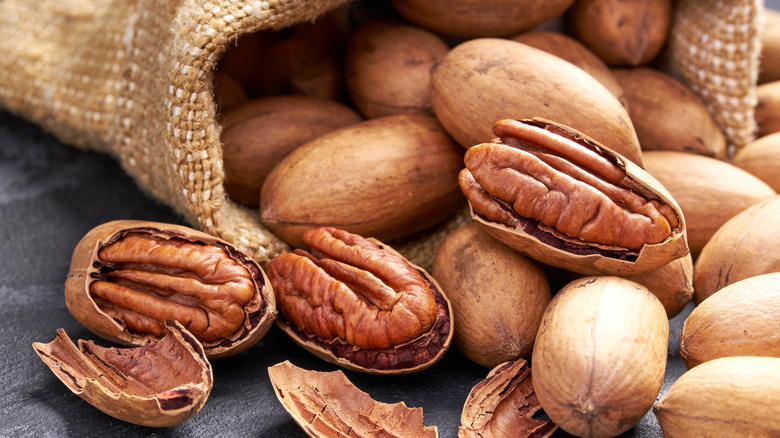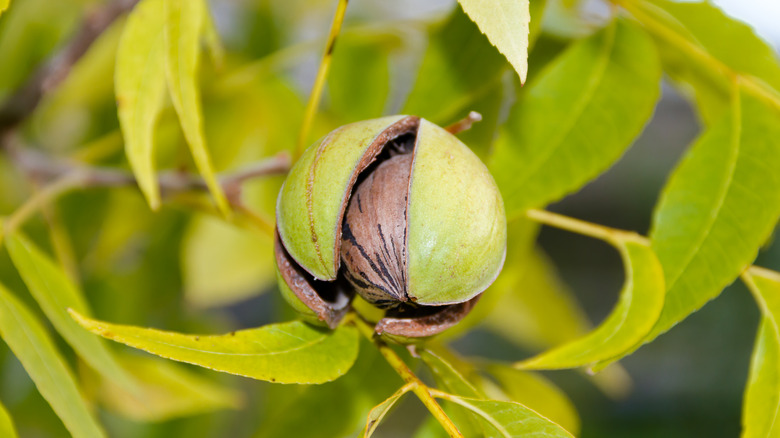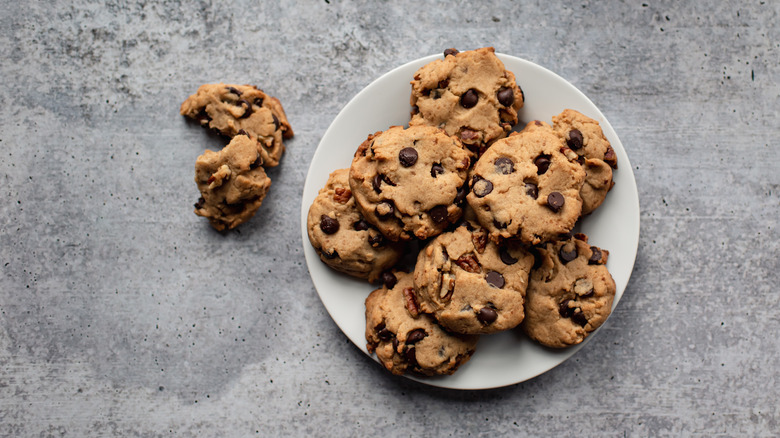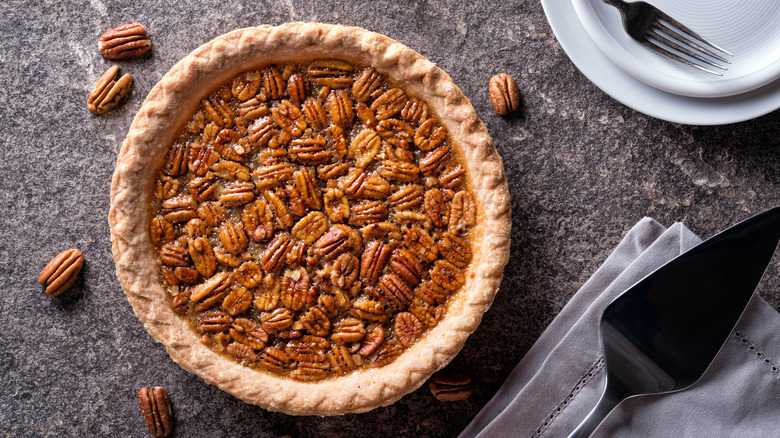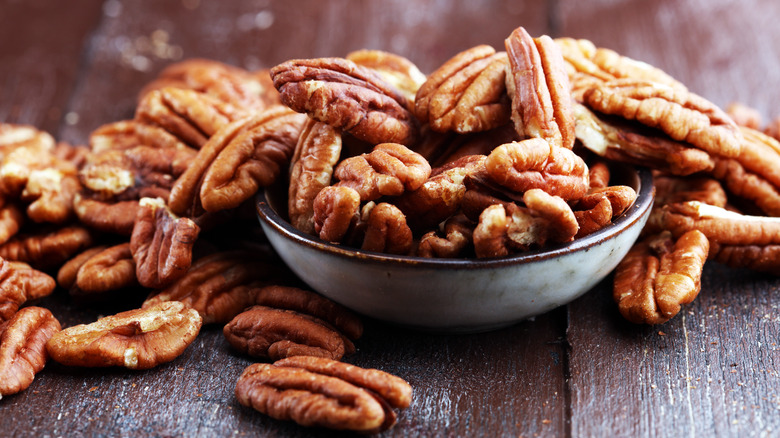Everything You Need To Know About Pecans
Have you ever thought about how cool it is that there are about 20 different kinds of nuts? Pecans — scientifically known as Carya illinoinensis — are just one of the many on that list. They offer flavor, crunch, and charm to many dishes and can be used in anything from holiday pies to homemade nut butter.
Originating from the central and eastern parts of North America, pecans also thrive on the river valleys of Mexico. They were traditionally eaten by pre-colonial residents not only for their taste and texture, but also because they were easier to find and shell than other North American nuts, explains the Hudson Pecan Company. It was not until 1772 that pecans were first planted in the U.S., with the country's first-ever pecan tree taking root on Long Island, New York. After that, presidents such as George Washington and Thomas Jefferson were inspired to plant their own pecan trees (via Cane River Pecan). Soon after, this interesting fruit took off and hasn't looked back since.
How are pecans grown?
While we know many different types of fruits as nuts, pecans, along with chestnuts, hazelnuts, and walnuts, are actually considered "true" nuts by botanical definition. (Peanuts, for example, are technically legumes.) That's because pecans consist of the following parts: A hard husk, a protective inner shell, and the edible seed, the U.S. Forest Service explains. If you ever come across a pecan-producing hickory tree, look for its oblong, green-husked fruits; when you break one open, you'll find the nut. These trees need at least seven years of age before they can produce the nuts, but once they do, they can continue for 100 years, says U.S. Pecan.
Pecans have long been a major food source for North American indigenous people, and these days, they're still an important crop on the continent; the U.S. produces 80% of the world's pecans, according to U.S. Pecan. You'd think New York would be the top-producing state since that's where they were first planted, but nope: The most pecan-generating states are New Mexico, Texas, and Georgia. Head to these areas to sample delights like pecan pie.
What do pecans taste like?
While the two nuts may look similar and come from the same family of trees, there are many differences between pecans and walnuts. Pecans are complex and contain a multitude of flavor elements. To start, they have a distinctly sweet and buttery flavor. On the nose, you might detect a floral, almost middle-of-nature aroma reminiscent of a pine tree candle from Bath and Body Works. Finally, you may notice a hint of bitterness, but this usually gives way to the interior's sweet butteriness. Try a walnut, on the other hand, and you'll notice a much earthier flavor.
Half of the pecan-eating experience comes from taste, but the other half is all about the mouthfeel. The high oil content found in pecans gives them a unique mix of textures, such as crispy, but also smooth. This results in a brittle, delicate nut that's just as easy to chop for cooking as it is to devour in a snack mix.
How to cook with pecans
The ways you can cook with pecans are truly endless, and their decadent flavor makes them especially perfect to use in dishes for the holidays. Before actually cooking or baking with pecans, however, you have to prep the nuts. While it's easy to find shelled pecans in supermarkets, you may come across others that are sold straight from the tree. Start by cleaning the nuts, instructs Pearson Farm, then shelling them by hitting them with a hammer or other heavy object or squeezing them with a nutcracker or wire cutters.
Next, you may want to toast your pecans before incorporating them into a recipe, as this helps draw out their buttery flavor, according to The Pioneer Woman's website. Just be sure not to burn them. Culinary Hill says the best way to toast pecans is to put them on a sheet tray in a 350-degree oven for five to 10 minutes, monitoring closely. If you're short on time, throw them in a skillet for two to five minutes over medium heat, tossing frequently, and remove when fragrant.
If you need recipe ideas, Mashed's pecan pie is one to save. Just combine staples like butter, sugar, eggs, and the pecans, add to a pie crust, and bake. For a dinner side, our sweet potato casserole is another top-notch option that pairs well with turkey and veggies. And when you can't be bothered to turn on the oven, you can use pecans to quickly add crunch to salads, grain bowls, or your morning yogurt.
Nutritional information about pecans
Pecans are a rich, nutrient-packed snack. They are a great source of copper, thiamine, and zinc. Copper helps with nerve cell function and immune health, whereas zinc does wonders for cell growth and brain function. In a single ounce (or 28 grams) of pecans, you'll get 196 calories, 2.5 grams of protein, 20.5 grams of fat, 4 grams of carbs, and 2.7 grams of fiber, Healthline breaks down. On top of that, you'll get 38% of your daily value of copper, 16% of thiamine, 12% of zinc, 8% of magnesium, and 6% of phosphorus.
Fun fact: Pecans are actually a top-15 food when it comes to having the highest levels of antioxidants, says Medical News Daily. They are also excellent for improving heart problems, aiding digestion, helping with weight loss, and boosting the immune system (via Millican Pecan). If you are looking for a reason to not eat these super nuts, we can't give you one.
